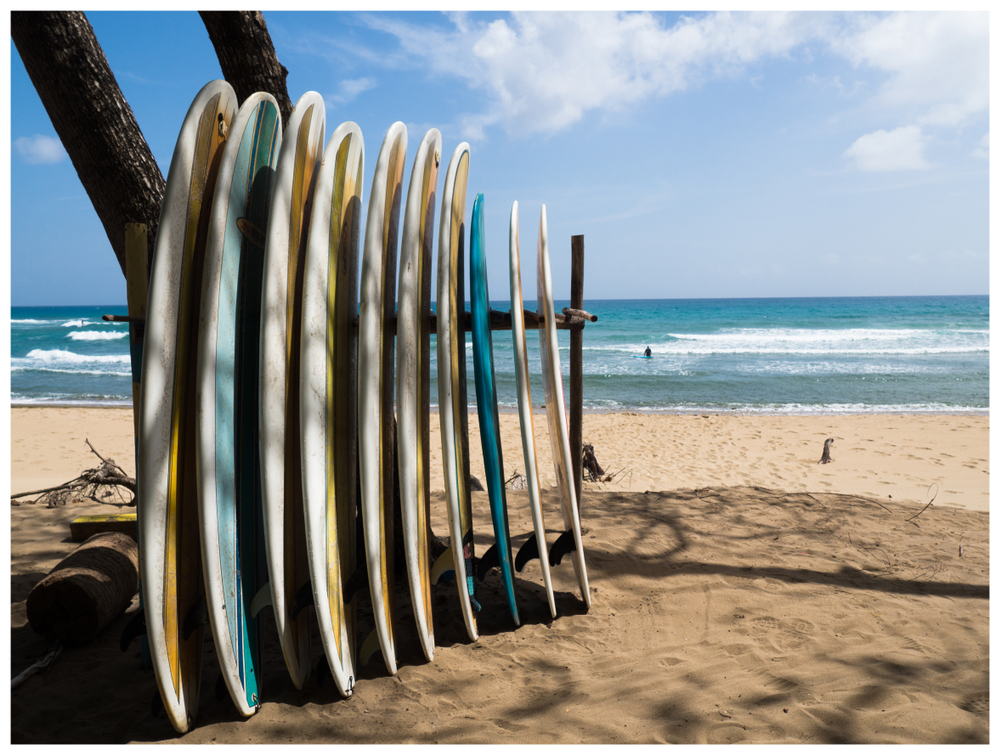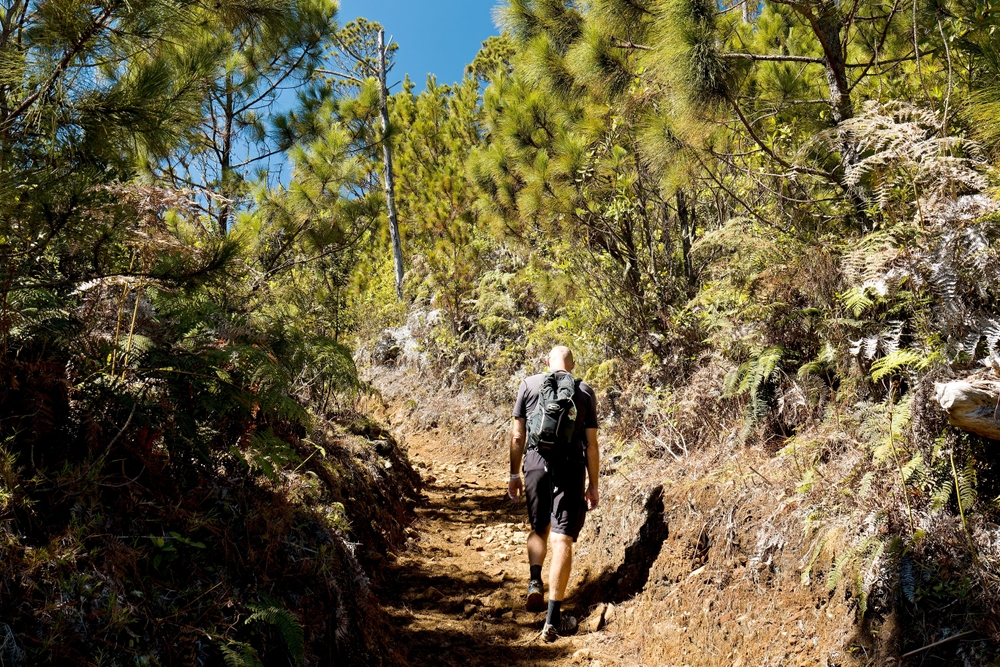Cabarete hardly misses a beat, even in a pouring tropical deluge. Arrive by taxi along the main coastal road from Puerto Plata on a mid-summer day, and the route into this ever-lively resort town swiftly becomes jammed with traffic—cars, taxis, the local guaguas (mini-vans that make frequent stops), and of course the Dominican favorite, the motorbike. As they enter the center of town, all ply their way at maximum speed along the two-lane road overburdened with the rush to development on this stretch of the Dominican Republic’s northern coastline. Still, the spirit that keeps Cabarete pulsing and thriving remains on display along the rain-clogged main artery: surfers dodge past front fenders on their way back to the beach, an open air vendor optimistically keeps his place next to his stand selling sunglasses, blond teenagers negotiate earnestly with the owners of motoconchos, a hair-raising means of commercial motorcycle transport.
Cradle, playground, and arena for extreme water sport
A town whose boom has been fueled by air and water, Cabarete remains largely defined by its still-expanding ocean front life. Nothing much interrupts that devotion to the waves here: so even in a passing storm, water sport enthusiasts of every kind hang out patiently by the bars, sports shops and coffee bars lining the sands, waiting for the sun to break through pearl grey storm clouds before relaunching themselves onto the ocean. Wake up to a flawless day that follows such weather, and you may be transfixed by the profusion of color and motion along and above Cabarete’s shoreline. The waters from the eastern side of the bay’s curve to its midpoint are dominated by the fast-skimming sails of windsurfers. Stretching toward and beyond the bay’s western curve, the sky is filled with the curved shape of huge kites maneuvered by the boarders racing across the waves below.

Originally discovered in the mid-Eighties as a destination for windsurfing thanks to its near-perfect offshore conditions, Cabarete began to attract an even wider following with the advent of kiteboarding (or kitesurfing) as the new millennium arrived. A hybrid born of harnessing surfboard and kite, kiteboarding has rapidly evolved both technically and athletically into its own distinct sport. At the same time, other adventure opportunities abound locally nearby, both aquatic and land-based, ranging from more venerable surfing to kayaking, scuba, and inland excursions into the mountains and forests of lush Hispaniola. Still, the growth activity among travelers to this area of the island continues to be kiteboarding, stimulated by a combination of annual world-class events, the solid following among experienced and pro kiteboarders, and the supportive presence of schools and facilities—all of which in turn bring the novice kiteboarders.

So what might a newcomer to this newest extreme water sport expect from a first-time learning session? One overview comes from Jörg Berres, who heads the No Work Team that instructs at Big Air Kite School. German-born Jörg points westward, indicating a preferred stretch of beach: “We use Bozo Beach, which is just beside the school and a little bit downwind. Then in winter when the waves are too big, we go a little bit further down the curve where there’s a nice spot with less waves and good winds.” Kiteboarding needs to be taken in easy but careful steps, as Jörg outlines: “What we do the first day, is just to learn to get control over the kite. We start with very small trainer kites of just about two meters, first on the beach to learn control, and then we continue with tube kites—small ones still. This is still the first stages—learning control of the kite on the beach. The next step is the second day, when we go into the water just with the kite, to learn the pull of the kite.” Progress continues rapidly so that by the third day most aspiring boarders are actually ready to launch into their first solo offshore run. “They have to stay under the eye of the school until they’re able to go out with the board and come back to the same place,” he emphasizes: “Until they’re able to do this, they should have an assistant from a kite school who is watching, helping them with going out and returning. Here in Cabarete, we have perfect conditions because the wind is right onshore–which means it’s quite easy to go out, and it’s also very easy to come back!”
Another option for both kiteboard and windsurfing novices and experts alike is Cabarete Windsportsclub (www.cabaretewindsportsclub.com), which is one of the oldest local operators of its kind, having grown from a windsurf school into its present wider range of operations. Its success also inspired the construction of the adjacent Villa Taina (www.villataina.com), a small well-appointed hotel totally geared to the high-tech and wind sport needs of its global clientele. Nowadays, the surf station remains busy year-round with guests, students, and visiting extreme sport pros who all rely on the state-of-the-art gear or instruction here.
Inland – mountains, villages, waterfalls
Having attracted the legions of extreme water sport followers from around the globe, Cabarete has also seen the expansion of its eco-adventure side move along with equal energy. Nowadays, outdoor enthusiasts arrive to also sample the range of land-based activities that include mountain biking, trekking, canyoning and cascading and horseback riding. The terrain inland from this part of the Dominican coast certainly provides the opportunity to experience it all, from the highest mountain elevation in the Caribbean —Pico Duarte, at some 10,128 feet above sea level—and inside the country’s parks system there are abundant trails. The most efficient way to include some land adventure, however, is to use the services of a well established outfitter in your activity of choice who can take care of all the details (food, permits, routes, guides). Probably the best established and most versatile local operator, with an office front right on Carretara in town, is Iguana Mama Shore Excursions (www.iguanamama.com), which tailors their adventures to suit all levels of physical accomplishment. “We do everything from a half-day to a 12-day tour right across the island, from the Atlantic coast in the north to the Caribbean in the south,” says owner, Michael Scates. Most popular of all: their half-day and downhill mountain bike outings, which only require that you know how to ride a bike. Michael describes the typical experience: “You take the transport up to the top, where you have breakfast and have fantastic views of the valley. The transport also drops off the bikes, so you just get on and go downhill. There’s two off-road sections—one which involves a river crossing which is really nice. When you finish up, you stop for a swim at a river with places to jump in off the cliff. On the full day tour, we go to a place called Blue Moon Retreat, where you have an East Indian lunch up in a spectacular thatched roof dining kiosk. The surrounding country is very lush and green with palm trees, and you can see the sea below. It’s really a good way of just getting out of the Cabarete scene and up into the clean air of the hills, and seeing a bit of the real countryside, because you’re riding through Dominican villages.

If you are more inclined toward adventuring on foot or horseback, those are other well-designed options that Iguana Mama has going on year-round: for instance, a three-day hike will get you up to the summit of Pico Duarte, highest point of elevation in the entire Caribbean at over 3,000 feet, passing by fir and pine forests on the way and assisted by local Dominican guides and pack mules. “The other thing that’s quite popular is the cascading, which we call the waterfall hike—actually it’s only about 20 minutes of hiking, and the rest of it is climbing up waterfalls and having great fun jumping and sliding and swimming back down again. It’s a group of waterfalls– there’s 27 of them–but we usually just climb up to about number 12.” Half-day long horseback rides also take on the local mountain terrain on small, semi-wild horses that are expert at picking their way up the rocky surfaces. For an entirely different equestrian experience, however, there is the beach ride, where sand and sea are at the edge of a gallop along a stretch of the pristine coastline.
While Cabarete pushes enthusiastically into the twenty-first century as a still-growing mecca for water sport and adventure travelers, those among its eco-conscious residents also look toward ways to ease the impact of that growth on local environment, its resources and infrastructure. However this continues to develop and expand, Cabarete’s evolution seems likely to remain a fascinating one: as a lively international little town, as an extreme water sport playground and launching point into the Dominican hinterlands, but also as a community seeking sustainable methods in which to live and play. And no doubt, like the determined youth always finding his balance on a board hereabouts, Cabarete itself will master that balance to keep sailing forward with its own enduring energy and style.



